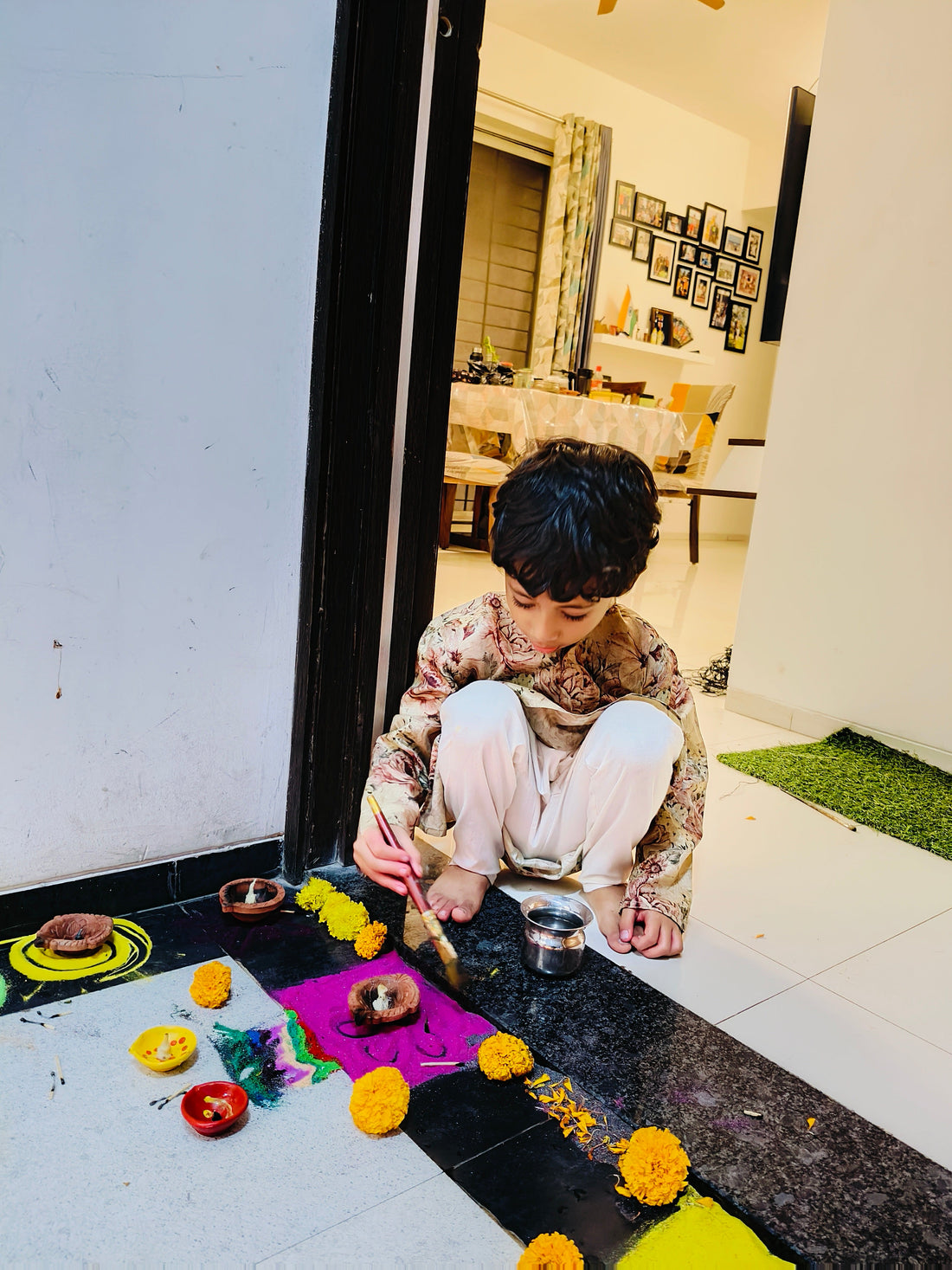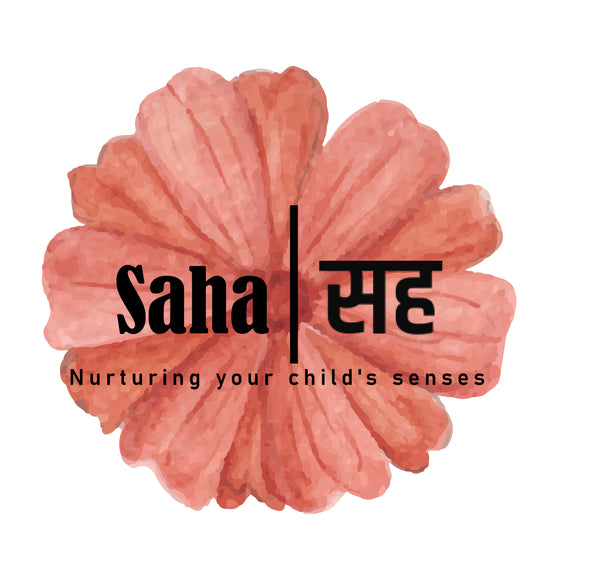
Do’s and Don’ts This Diwali Vacation — A Waldorf-Inspired Guide to Mindful Festivity
Share
Festivals are a time of joy, community, and connection. They fill our homes with laughter, light, and the smell of sweets. For children, these moments often become treasured memories that shape their sense of belonging and celebration.
But amidst the excitement, it’s easy for the rhythm of daily life to vanish — sleep times stretch late into the night, meals become irregular, and days are filled with stimulation from screens, fireworks, and social visits. What begins as joy can sometimes tip into overwhelm, especially for young children whose senses are still tender and developing.
As parents and caregivers, we have the beautiful responsibility of creating an environment where celebration feels nourishing rather than exhausting. The Waldorf approach offers gentle yet profound wisdom for this — emphasizing rhythm, sensory balance, and soulful connection over speed and excess.
This Diwali, let’s slow down and celebrate with intention. Here’s a guide to the do’s and don’ts for a mindful, Waldorf-inspired holiday.
1. Do: Follow a Gentle Daily Rhythm
In Waldorf education, rhythm is seen as one of the most essential aspects of healthy childhood. It provides children with a sense of safety and predictability in a world that can often feel too big and fast.
Even during vacations, maintaining a gentle rhythm helps your child stay centered. It doesn’t have to be strict — it can be as simple as anchoring the day around a few steady points:
- Waking up and going to bed at roughly the same time each day.
- Beginning mornings quietly — watering plants, lighting a diya, or sharing breakfast as a family.
- Keeping a daily ritual, such as evening lamps or story time, that signals closure and peace.
When we hold a rhythm, children can relax into the day. They know what’s coming next, which allows them to engage more fully in the moment.
Don’t: Let go of all structure in the name of 'holiday freedom.' While flexibility is healthy, complete unpredictability can make children anxious or irritable. A balanced rhythm gives them both stability and space for joy.
2. Do: Balance “Breathe In” and “Breathe Out” Times
One of the most beautiful concepts from Waldorf pedagogy is the idea of breathing — the rhythm between expansion (breathe out) and contraction (breathe in).
Children, just like adults, need this alternation between activity and rest, noise and silence, outer engagement and inner stillness.
Breathe Out moments are the active parts of the day:
- Decorating the home together
- Visiting relatives or friends
- Playing outdoors or participating in festivities
- Dancing, singing, or lighting sparklers
Breathe In moments are those that restore calm and inner quiet:
- Listening to stories or gentle music
- Painting or modeling clay quietly
- Watching the flame of a diya
- Lying under the stars and simply being
When we consciously weave both into our days, we support healthy sensory and emotional processing. Children begin to feel when they need rest and when they are ready to move again — a life skill that will serve them far beyond childhood.
Don’t: Fill the calendar with back-to-back outings, shopping trips, and parties. Even though these may look fun, they can overstimulate young children and lead to emotional meltdowns or restlessness.
3. Do: Keep the Festival Meaningful
Festivals carry deep symbolic meaning — light triumphing over darkness, goodness over greed, hope over despair. When we take time to share these stories with children, we help them connect with the inner spirit of Diwali rather than just the outer sparkle.
Invite your child to participate in the preparations in age-appropriate ways:
- Cleaning and decorating your home together
- Making simple diyas, rangolis, or paper lanterns
- Cooking or wrapping homemade sweets for friends and family
Let them feel that festivals are created by us, not for us. The act of creating — sweeping, crafting, cooking — is meditative and grounding. It also instills respect for the effort that goes into celebration.
Don’t: Reduce the festival to consumption — endless gifts, online shopping, or passive entertainment. Children learn best through doing, not watching. When we invite them to create, they experience the festival through their senses and their heart.
4. Do: Choose Simple, Sensory-Rich Experiences
Children experience the world through their senses — the smell of ghee lamps, the warmth of soft cotton clothes, the texture of handmade decorations. These sensory experiences build deep, joyful memories and shape how children connect with beauty and peace.
Keep Diwali celebrations natural and sensory-rich:
- Light handmade earthen lamps instead of electric ones.
- Use flowers, leaves, and natural colors for decoration.
- Choose wooden toys and organic fabrics that are gentle to touch and smell.
- Involve all five senses in meaningful, grounded ways.
Don’t: Overstimulate with loud music, flashing lights, or plastic decorations. Synthetic sounds and visuals can tire a child’s senses quickly, making them restless or disengaged. A quieter beauty nourishes far more deeply.
5. Do: Create Space for Connection
The essence of every festival is togetherness. Children may forget the exact sweets they ate or the gifts they received, but they will always remember how it felt to be with family.
Create small, heartful moments of connection:
- Share childhood stories by candlelight.
- Invite grandparents to tell traditional tales.
- Sit together while wrapping sweets or making decorations.
- Let your child take the lead in lighting the diya or saying a simple blessing.
These gestures build a sense of belonging — a feeling that “I am part of something meaningful.”
Don’t: Let the festival slip away in checklists, errands, and photos. The best memories are lived, not staged.
6. Do: Protect Rest and Downtime
Holidays are also a chance for the body and mind to rest. Guard your child’s sleep as something sacred. Children who are well-rested are calmer, more imaginative, and more receptive to joy.
Create small pauses during the day — an afternoon story, quiet music, or lying together and watching the diya glow. Stillness is not the opposite of celebration; it’s what gives it depth.
Don’t: Let excitement stretch late into every night. The nervous system of a young child needs rhythm and restoration to stay balanced.
A Closing Thought
Diwali is often described as the festival of light, but its real beauty shines when that light glows within us — calm, warm, and steady.
When we simplify celebrations, follow a rhythm, and honor both activity and rest, we give our children something far greater than toys or sweets — we give them a sense of inner peace and belonging.
Festivals are not meant to overwhelm the senses but to awaken them gently. As Waldorf pedagogy reminds us, childhood should be filled not with noise and spectacle, but with wonder — the quiet kind that lives in handmade moments, flickering lamps, and unhurried joy.
So this Diwali, light fewer lamps perhaps, but let each one burn with presence, intention, and love.
